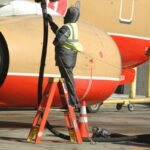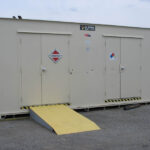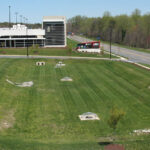Materials that are used for the deicing of aircraft include propylene glycol. Proper handling and usage of deicing and anti-icing materials is important as propylene glycol exerts a very high biochemical oxygen demand (BOD) on receiving waters. The effect of increased BOD is the depletion of dissolved oxygen levels in the water, which deprives aquatic life of oxygen.
Pavement deicing on runways and taxiway surfaces ensures that there is adequate traction for aircraft during taxing, take off, and landing. Materials used, such as sodium acetate and potassium acetate, have been chosen as they are more environmentally friendly, but they should still be handled properly to minimize over application or spillage.
To limit the amount of deicing materials from entering the environment, the MAA has constructed dedicated aircraft deicing pads, and gate deicing fluid collection drains that allow the airport to divert deicing fluid into a collection system and storage facility. Spent deicing fluid then sent to Dulles Airport for recycling or to the wastewater treatment plant for treatment and disposal.
In addition, the MAA has instituted the use of Glycol Recovery Vehicles (GRV) to vacuum deicing fluid off the pavement.
The MAA has developed Stormwater Pollution Prevention Plans (SWPPPs) for both BWI Marshall and Martin State Airport National Pollutant Discharge Elimination System (NPDES) permits. The plans identify best management practices for both MAA staff and tenants related to deicing activities.
Additionally, Tenant Directive 215.1 (Aircraft Deicing Procedures at Baltimore/Washington International Thurgood Marshall Airport) establishes procedures and restrictions for the defrosting/deicing of aircraft, specifies where aircraft deicing can be conducted, and establishes procedures for reporting the use of aircraft deicing fluid. These procedures assure that deicing is performed in areas with controls to minimize environmental impacts as well as assure compliance with the conditions of the airport’s NPDES stormwater permit.
Some examples of best management practices tenants can adopt include:
Deicing/Anti-icing Aircraft
- Evaluate present operating procedures to consider alternative practices that would reduce the overall amount of deicing/anti-icing chemical used and/or lessen the environmental impact of the pollutant source.
- Remove accumulations of snow and ice on aircraft manually or with forced air prior to the application of chemical deicer.
- Adjust the concentration of glycol in aircraft deicers to suit ambient air temperature consistent with FAA guidance.
- Apply anti-icer to aircraft that will be parked overnight to make it easier to remove accumulated snow and ice in the morning.
- Apply anti-icer to aircraft immediately after deicing to provide extended hold-over time prior to take-off.
- Ensure proper handling and disposal of unused deicing fluids.
Deicing/Anti-icing Runways
- Evaluate and optimize current chemical application rates.
- Use sand where possible to enhance friction.
- Plow and sweep runways prior to application of deicing chemicals.
- Heat solid deicers and sand prior to application.
- Install and calibrate devices to meter the amount of pavement deicer being applied.
- Emphasize anti-icing operations that minimize the need to deice.
- Pre-wet with liquid deicers to improve adhesion of solid deicers to the iced surface.
- Use deicers that have less of an environmental impact (e.g. sodium formate, sodium acetate and potassium acetate as opposed to urea and glycol).
- Ensure proper handling and disposal of unused deicing chemicals.
- Use ice detection systems.
One of the requirements of tenant leases is that tenants must adhere to the requirements of the applicable tenant directives and associated regulations. Not adhering to these requirements can impact the standing of the tenant lease.
Additionally, many of the best management practices identified above are those included in the Stormwater Pollution Prevention Plan, which is applicable to both the MAA and tenants at the airport. Not implementing best management practices in association with tenant activities may result in the contamination of stormwater at the airport. As a result, the MAA and tenants may face civil or criminal penalties (see Part II.C.15 and 16 of the NPDES Permit available on the Resource Documents page for more details).




